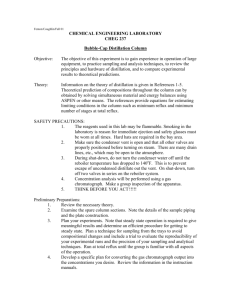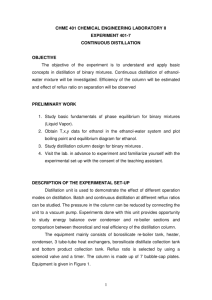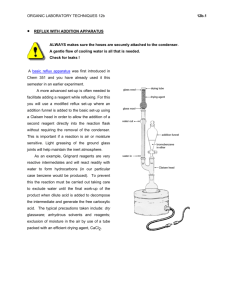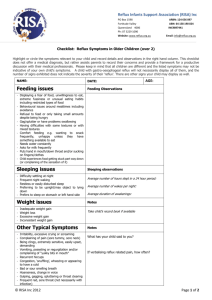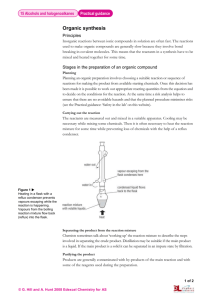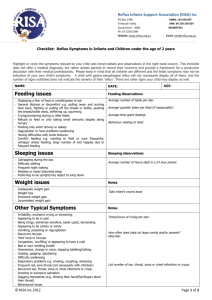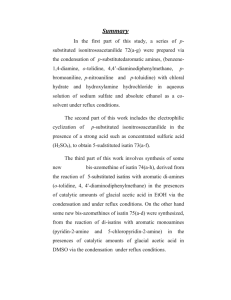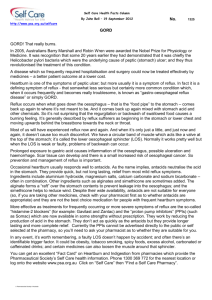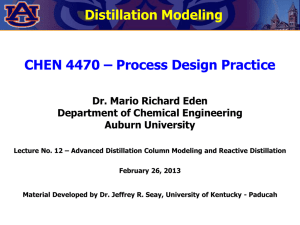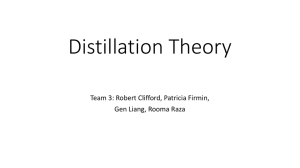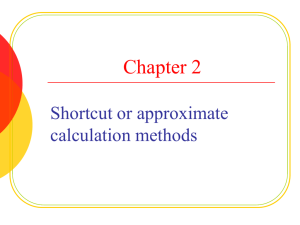Example: multicomponent distillation with shortcut methods
advertisement
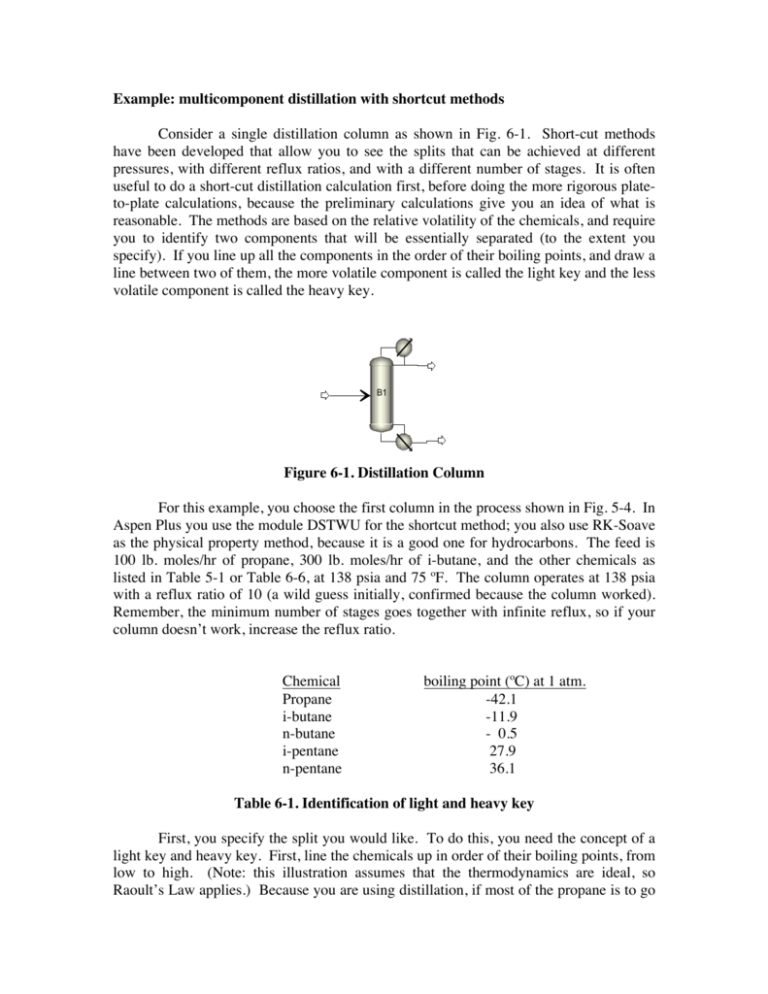
Example: multicomponent distillation with shortcut methods Consider a single distillation column as shown in Fig. 6-1. Short-cut methods have been developed that allow you to see the splits that can be achieved at different pressures, with different reflux ratios, and with a different number of stages. It is often useful to do a short-cut distillation calculation first, before doing the more rigorous plateto-plate calculations, because the preliminary calculations give you an idea of what is reasonable. The methods are based on the relative volatility of the chemicals, and require you to identify two components that will be essentially separated (to the extent you specify). If you line up all the components in the order of their boiling points, and draw a line between two of them, the more volatile component is called the light key and the less volatile component is called the heavy key. B1 Figure 6-1. Distillation Column For this example, you choose the first column in the process shown in Fig. 5-4. In Aspen Plus you use the module DSTWU for the shortcut method; you also use RK-Soave as the physical property method, because it is a good one for hydrocarbons. The feed is 100 lb. moles/hr of propane, 300 lb. moles/hr of i-butane, and the other chemicals as listed in Table 5-1 or Table 6-6, at 138 psia and 75 ºF. The column operates at 138 psia with a reflux ratio of 10 (a wild guess initially, confirmed because the column worked). 1 Remember, the minimum number of stages goes together with infinite reflux, so if your column doesn’t work, increase the reflux ratio. Chemical Propane i-butane n-butane i-pentane n-pentane boiling point (ºC) at 1 atm. -42.1 -11.9 - 0.5 27.9 36.1 Table 6-1. Identification of light and heavy key First, you specify the split you would like. To do this, you need the concept of a light key and heavy key. First, line the chemicals up in order of their boiling points, from low to high. (Note: this illustration assumes that the thermodynamics are ideal, so Raoult’s Law applies.) Because you are using distillation, if most of the propane is to go out the top stream, a little of the i-butane will, too; very small fractions of the other species will go out the top stream. You want most of the i-butane to go out the bottom. Thus, you draw a line between propane and i-butane in Table 6-1. The component above the line is the light key and the component below the line is the heavy key. The distillation column is based on those two components, and the other components are split according to thermodynamics as described below. In this case, propane is the light key, and you want 99% of it to go out the top stream; i-butane is the heavy key, and you want 1% of it to go out the top stream. Mathematical development. Although you have Aspen Plus to do the calculations, it is instructive to see what equations are being used. First, you need the relative volatility of the light key to the heavy key, which is determined by thermodynamics alone ( using the K-values). α LK = K LK K , αi = i K HK K HK (6.1) Then, use the Fenske equation (Fenske, 1932). € r 1− rHK (α LK ) Sm = ( LK )( ) 1− rLK rHK (6.2) where Sm = minimum number of stages ri = recovery fraction of i - th component rLK = recovery fraction of light key component rHK = recovery fraction of heavy key component € Since you specify the fraction of the light and heavy keys, you can use the Fenske equation to obtain the minimum number of stages. Once the minimum number of stages € is determined, you can find the the splits of the other components from Eq. (6.3). r 1− rHK (α i ) Sm = ( i )( ) 1− ri rHK (6.3) The next step is to solve the Underwood equation (Underwood, 1932) for the variable ϕ . € q(1− F) = ∑ i where € α i n i,F αi − ϕ (6.4) € q = 0 is saturated vapor feed q = 1 is saturated liquid feed n i,F = feed flow rate of i - th component F = total feed flow rate, = ∑n i,F i € This is a non-linear equation in one unknown, which is a class of problems you know how to solve from Chapter 2. Then, you calculate the minimum vapor flow rate using Eq. (6.5). Vmin = ∑ i α i n i,D , n i,D ≈ n i,F αi − ϕ (6.5) Vmin = Rmin + D where € Vmin = minimum vapor flow rate n i,D = distillate flow rate of i - th component Rmin = minimum reflux rate D = distillate flow rate R = reflux ratio = reflux rate/D Rm = minimum reflux ratio = Rmin /D Vapor rate = reflux rate + D Note in this description the words reflux rate and reflux ratio. They are different, and you need to be careful to use the right one, since using too small a reflux rate could make € your column not work. Finally, you use the Eduljee version (Eduljee, 1975) of the Gilliland correlation (Gilliland, 1940) – Eq. (6.6) – to find the actual number of stages. This equation correlates data on roughly one hundred distillation columns. You must specify either the reflux ratio (R) or number of stages (S) in order to use this equation. ) # R − R & 0.5668 , S − Sm m = 0.75+1− % . ( S +1 * $ R +1 ' - In this entire process, only one equation could not be solved analytically: Eq. (6.4). In order to solve the problem, you needed the K-values of the chemicals (or vapor € pressures), the flow rates of the feed stream, the thermal condition of the feed stream, the desired split for the light and heavy keys, and either the number of stages or the reflux ratio. The equations then find the splits of all the other components, the minimum number of stages, the minimum reflux rate, and the actual number of stages needed to achieve the desired split. These last three items are very useful when using a more rigorous method of calculation, as shown below. (6.6) If the relative volatility varies from the top to the bottom of the column, you can use the geometric mean of the values at the top and bottom (Seader, et al. 1997, p. 1335): α = (α topα bottom )1/ 2 (6.7) Winn (1958) developed another way to handle this problem with a correlation for the relative volatility, and which is used by Aspen Plus. Additional details about shortcut € methods are available in King (1980) and Perry’s Chemical Engineers’ Handbook (2008). You can use Aspen Plus to solve this problem using the DSTWU block, which stands for DiSTillation-Winn-Underwood. See Chapter 6. References Eduljee, H.E., Hydro. Proc., 1975; 54, (9), p. 120. Fenske, M. R. Fractionation of straight-run Pennsylvania gasoline, Ind. Eng. Chem. 1932; 24 482-485. Gilliland, E. R., Multicomponent rectification: estimation of the numer of theoretical plates as a function of the reflux ratio. Ind. Eng. Chem., 1940; 32, 1220-1223. King, C. J., Separation Processes, 2nd ed. McGraw-Hill: New York, 1980. Perry, R. H., Green, D. W. (eds.), Perry’s Chemical Engineers’ Handbook, 8th ed. McGraw-Hill: New York, 2008. Seader, J. D., Siirola, J. J., Barnicki, S. D., Distillation. In Perry’s Chemical Engineers Handbook, 2008. Underwood, A. J. V, The theory and prctice of testing stills. Trans. Inst. Chem. Eng., 1932; 10, 112-158. Winn, F. W., New relative volatility method for distillation calculations. Petrol. Refin. 1958; 37, 216-218.
